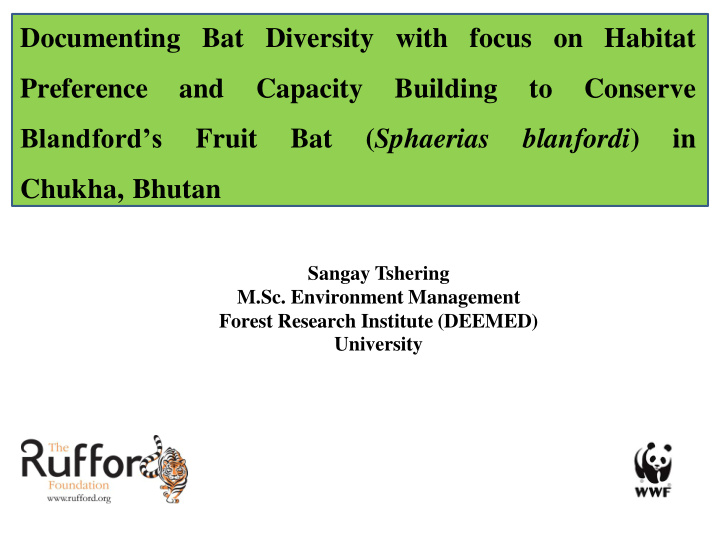



Documenting Bat Diversity with focus on Habitat Preference and Capacity Building to Conserve Blandford’s Fruit Bat ( Sphaerias blanfordi ) in Chukha, Bhutan Sangay Tshering M.Sc. Environment Management Forest Research Institute (DEEMED) University
Presentation outline Introduction Problem statement Objectives Materials and Methods Study area Research Design Data collection Materials used Data Analysis Results Conclusion Recommendation Acknowledgement
Introduction Small Mammals have highest diversity of known mammal species 5, 418 (Rajchal, 2007). The 1,116 bat species represent about 20% of the known small mammal species (Rajchal, 2007). Bats are the only flying mammals in which forelimbs are modified into wings and fly like birds and are perhaps the most easily recognizable group of animals. Bats are good pollinators, pest controllers and seed dispersers
Problem Statement Lack appropriate baseline information on bat diversity, habitats, geographic distribution and abundance. Only few specific species from Bhutan are reported for documentation in IUCN red list. The detail bat study was not done so far in Bhutan Lack Blandford ’ s data/no updated status on Fruit Bat ( Sphaerias blanfordi ) which was reported from Ganglakha under Chukha District in 2008 by IUCN Conservation organizations focus mainly on flagship species
Research Objectives Document bat diversity of Chukha District Assess disturbances and threats on bats of Chukha District Study vegetation preference of specific species for its protection and conservation To rediscover Blandford ’ s Fruit Bat ( Sphaerias blanfordi ) and it’s habitat assessment Carry out Conservation Capacity-Building through education and conservation awareness.
Materials and methods: Study area Chukha District covers an area of about 1,802 sq. km with elevations ranging from 200 to 3500 meters above sea level. It is one of the two districts without any protected areas in Bhutan Ganghlakha as habitat for Blandford ’ s Fruit Bat (IUCN, 2008) covers 247 sq. kilometers. Fig.1: Blandford’s Fruit Bat habitat in Study area
Research Design Sampling design: Stratified random sampling Sample size: Based on randomness 70% of blocks (Gewogs) and further 70% of village from each selected blocks were sampled for bat survey. Fig.2: Randomly selected research sites
Data Collection Set mist nets at various habitat types (forests, streams, Orchards and around human habitation. Sex, weight and measurements of A bats were done. B Recorded geographical coordinates (latitude, longitude, altitude. C D Fig.3: A. Bat bags, B. Mist net, C. Bat identification and D. Measuring weight of bat
Data Collection Use of hand nets (hoop- nets) Bat search in its roosting sites during day time recorded. A B Anthropogenic activities: mining, timber extraction, roost disturbance etc. C D Fig.4: A. Bat roosts, B. Measuring wingspan of bats, C. Bat capturing using hand net and D. Human disturbances and threats on bats
Materials used D E F A B C Fig. 5 : A. Pesola spring; B. Bamboo pole; C. V ernier caliper; D. Mist net; E. Hand gloves; F. Data sheet.
Safety Equipment C B A D Fig.6: A. Hand sanitizer, B. Gloves, C. Mask and D. Soap
Results – Bat captured Fig. 7 : A . Miniopterusfuliginosus Hodgson, 1835, B . Rhinolophus luctus and C . Rhinolophus macrotis
Results – Bat captured cont… D E F Fig. 8: D. Myotis siligorensis, E. Hipposideros armiger and F. Rhinolophus affinis
Results – Bat captured cont… H I G Fig. 9: G. Rhinolophus sinicus, H. Myotis longipes and I. Myotis siligorensis
Results – Bat captured cont… K J Fig. 10: J. Rhinolophus lepidus (Blyth, 1844) and K. Rhinolophus pusillus (Temminck, 1834)
Results cont… Threats percentage in captured site Threats percentage in un-capture site Intensity of threats in percentage 30 25 20 15 10 5 0 Free grazing Timber Firewood Bamboo Quarry Road Human extraction collection extraction construction disturbance Conservation threats Fig 11: Types of conservation threats
Results cont… Total Hipposideridae Vespertilionidae 35 Total no. of individuals captured Rhinolophidae Miniopteridae 30 25 20 15 10 5 0 S SW W NW N NE E SE Aspect Fig 12: Response of bats to aspect
Conservation capacity building B A C D Fig. 13: Conservation awareness in levels: A. Students (trainees), B. Local, Stakeholders C. and D. Interview survey
Challenges in bat research A B C D Fig. 14: A. Night work without locals to guide, B. Prey to leeches, C. and D. Nocturnal insects destroying mist nets
Conclusion The species diversity of bats were comparatively high in Rhinolophus spp followed by Vespertilionidae spp and least in Miniopteridae spp and Hipposideridae spp . Total number of bat species captured was strongly associated to aspects. Firewood collection followed by free grazing has high intensity disturbance compared to other conservation threats. Local residents are not aware of bat diversity and they have different perceptions on bats.
Recommendation Conservation awareness are strictly recommended to reach sustainability in conservation of bats. Anthropogenic activities like mining, free grazing, firewood collection etc. should be monitored. Community engagement in bat studies for effective conservation. Organizations and institutes like WWF Bhutan, RSPN, UWICE, DoFPS etc. need to focus on bat research as species go extinct unnoticed and also to document comprehensive list of bat species of Bhutan.
Acknowledgement WWF Bhutan and Rufford Foundation for financial support Dr. Neil M Furey, Dr. Gabor Csorba, Dr. Manuel Ruedi, Dr. Rajesh Puttaswamaiah and Dr. Tu Vuong Tan for their invaluable inputs on bat identification Mr. Rohit Chakravarty for sharing tips on bat species confirmation UWICE and Chhukha Dzongkhag administration for permitting me to conduct research Mr. Tashi Dendup and Dr. DB Gurung, Dr. Phub Dorji of CNR for sacrificing their classes to conduct conservation awareness. Local leaders and villagers of respective Gewogs for their kind support. Thanks to my parents for their constant inspiration and believing in me.
THANK YOU FOR YOUR TIME
Recommend
More recommend